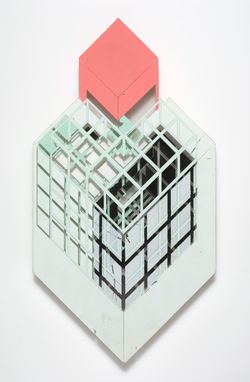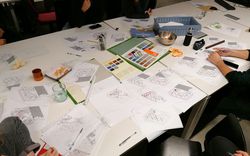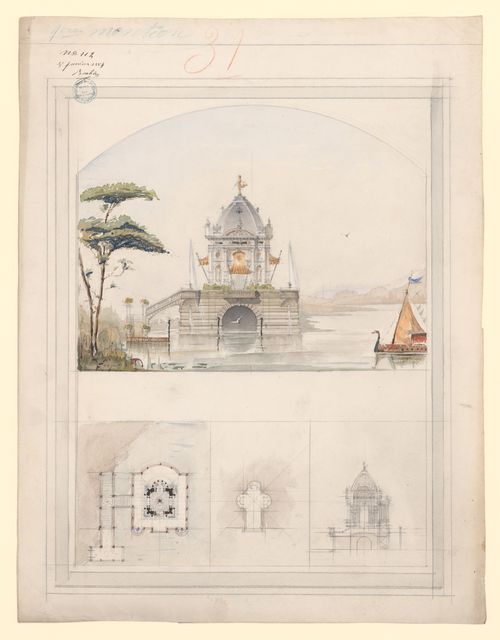Through the work of internationally renowned architects, this exhibition reveals the presence of utopian modernist ideas thought to have been discarded with the advent of the postmodern era. According to the exhibition’s lead curator Reinhold Martin, much of the architectural production of the last half-century has been haunted by the ghosts of modernist utopias: “The(...)
Octagonal gallery
28 February 2008 to 25 May 2008
Utopia's Ghost: Postmodernism Reconsidered
Actions:
Description:
Through the work of internationally renowned architects, this exhibition reveals the presence of utopian modernist ideas thought to have been discarded with the advent of the postmodern era. According to the exhibition’s lead curator Reinhold Martin, much of the architectural production of the last half-century has been haunted by the ghosts of modernist utopias: “The(...)
Octagonal gallery
archives
Level of archival description:
Collection
Ciudad del Sol collection
CD050
Synopsis:
This collection largely documents Pietro Roveda’s Ciudad del Sol project in Mexico from 1907 – 1913. The project was a planned community for workers – a community model that Roveda proposed to implement internationally. The project is documented through planning and presentation materials, reports, newspaper clippings, correspondence, limited drawings, and stationery items.
1907 - 1913
Ciudad del Sol collection
Actions:
CD050
Synopsis:
This collection largely documents Pietro Roveda’s Ciudad del Sol project in Mexico from 1907 – 1913. The project was a planned community for workers – a community model that Roveda proposed to implement internationally. The project is documented through planning and presentation materials, reports, newspaper clippings, correspondence, limited drawings, and stationery items.
archives
Level of archival description:
collection documentaire
1907 - 1913
articles
With and Within
cooperativism, collective, barcelona, spain, la borda, can batlló, social economy, indignados, context
19 April 2021
The Architecture of Cooperation
Kim Courrèges and Felipe de Ferrari of Plan Común speak with Carles Baiges and Cristina Gamboa of Lacol
Actions:
With and Within
Project
CI005.S1.1937.PR1
Description:
In 1937, the Bataafsche Import Maatschappij (The Batavian Import Company), established a building programme for new headquarters within The Hague. The company wished to create office space for 600 employees. The company invited competition entries from four architects, including Oud. Oud's design was approved in 1939 and included a rectangular block of rooms oriented around a central corridor with office spaces separated by partitions. The building was surrounded by a garden. Oud also created designs for a possible future expansion and later designed office furnishings. While construction was interrupted by the war, the company proceeded with minimum construction until its restoration and continued expansion. Oud assisted with restoration after its bombing by Allied forces in 1945. The erected building was criticised for its traditional decorative patterns (Taverne et al. 2001, 411-414). Project series includes plans for the Shell Building, as well as a photograph of the building facades and one of the furniture.
1937-1942
Head Office of the Bataafsche Import Maatschappij (Shell Building), The Hague, Netherlands (1937-1942)
Actions:
CI005.S1.1937.PR1
Description:
In 1937, the Bataafsche Import Maatschappij (The Batavian Import Company), established a building programme for new headquarters within The Hague. The company wished to create office space for 600 employees. The company invited competition entries from four architects, including Oud. Oud's design was approved in 1939 and included a rectangular block of rooms oriented around a central corridor with office spaces separated by partitions. The building was surrounded by a garden. Oud also created designs for a possible future expansion and later designed office furnishings. While construction was interrupted by the war, the company proceeded with minimum construction until its restoration and continued expansion. Oud assisted with restoration after its bombing by Allied forces in 1945. The erected building was criticised for its traditional decorative patterns (Taverne et al. 2001, 411-414). Project series includes plans for the Shell Building, as well as a photograph of the building facades and one of the furniture.
project
1937-1942
Project
Royal Ottawa Regional Rehabilitation Centre, Ottawa Health Sciences Centre, Ottawa, Ontario (1974)
AP018.S1.1974.PR25
Description:
This project series documents the design and construction of the Royal Ottawa Regional Rehabilitation Centre in Ottawa, Ontario from 1974-1981. The office identified the project number as 7432. The Ottawa Heath Sciences Complex, a vast hospital network encompassing institutions across the city, hired Parkin Architects Planners in 1971 to design and construct University of Ottawa buildings within the network. These campus buildings were located in the Alta Vista neighbourhood and referred to as the Health Sciences Centre. This project consists of one building in that complex, the Royal Ottawa Regional Rehabilitation Centre. The distinction between these names should be noted when viewing the materials. The two-storey rehabilitation centre was constructed directly beside the Ottawa Health Sciences Building, another hospital in the network built by Parkin (see project series AP018.S1.1974.PR01 in this fonds). The proposal conceived a 145,000 square foot hospital with 77 in-patient beds. The design included space for patient accommodation, teaching, research, administrative activities, patient care and treatment, and a concession area. Patients at the hospital would range from those with severe brain injuries, to amputees, to those with rheumatic diseases. The building was carefully designed to accommodate the specialized needs of the patients. The hospital design also included a swimming pool, sports areas, and spaces for other leisure activities thought to aid in the rehabilitation process. The project is recorded through construction photographs, drawings, and textual materials dating from 1971-1983. The textual records include correspondence, specifications, schedules, contract data, conference reports and minutes, inspection reports, predesign notes, consultancy records, financial documents, change orders, supplementary instructions, research, and deficiency lists. The majority of these textual records deal with the hospital's construction, rather than design. Most drawings are reprographic copies of detail drawings and can be found within the textual records. Box AP018.S1.1974.PR25.002 contains an index to the textual records, which was created by the office.
1971-1983
Royal Ottawa Regional Rehabilitation Centre, Ottawa Health Sciences Centre, Ottawa, Ontario (1974)
Actions:
AP018.S1.1974.PR25
Description:
This project series documents the design and construction of the Royal Ottawa Regional Rehabilitation Centre in Ottawa, Ontario from 1974-1981. The office identified the project number as 7432. The Ottawa Heath Sciences Complex, a vast hospital network encompassing institutions across the city, hired Parkin Architects Planners in 1971 to design and construct University of Ottawa buildings within the network. These campus buildings were located in the Alta Vista neighbourhood and referred to as the Health Sciences Centre. This project consists of one building in that complex, the Royal Ottawa Regional Rehabilitation Centre. The distinction between these names should be noted when viewing the materials. The two-storey rehabilitation centre was constructed directly beside the Ottawa Health Sciences Building, another hospital in the network built by Parkin (see project series AP018.S1.1974.PR01 in this fonds). The proposal conceived a 145,000 square foot hospital with 77 in-patient beds. The design included space for patient accommodation, teaching, research, administrative activities, patient care and treatment, and a concession area. Patients at the hospital would range from those with severe brain injuries, to amputees, to those with rheumatic diseases. The building was carefully designed to accommodate the specialized needs of the patients. The hospital design also included a swimming pool, sports areas, and spaces for other leisure activities thought to aid in the rehabilitation process. The project is recorded through construction photographs, drawings, and textual materials dating from 1971-1983. The textual records include correspondence, specifications, schedules, contract data, conference reports and minutes, inspection reports, predesign notes, consultancy records, financial documents, change orders, supplementary instructions, research, and deficiency lists. The majority of these textual records deal with the hospital's construction, rather than design. Most drawings are reprographic copies of detail drawings and can be found within the textual records. Box AP018.S1.1974.PR25.002 contains an index to the textual records, which was created by the office.
Project
1971-1983
Project
AP206.S1.1986.PR01
Description:
This project series documents the Maharaja Aggarsain Public School in Kurukshetra, India from 1986-1987. The project consisted of a U-shaped building that surrounded a large playground courtyard and included a dormitory block on the west, a classroom block on the east and an auditorium block that joined the other two. In some schemes, a swimming pool block completes the square at the open end. The elevations facing the interior playground were lined with verandas that had large, repeated archway openings. The other elevations followed this style through the use of arched windows and doors. Additional courtyards placed evenly throughout the east and west blocks created communal spaces within the school. The project is recorded through drawings, most of which are originals, consisting of plans, elevations, sections and details dating from 1986-1987.
1986-1987
Maharaja Aggarsain Public School, Kurukshetra, India (1986-1987)
Actions:
AP206.S1.1986.PR01
Description:
This project series documents the Maharaja Aggarsain Public School in Kurukshetra, India from 1986-1987. The project consisted of a U-shaped building that surrounded a large playground courtyard and included a dormitory block on the west, a classroom block on the east and an auditorium block that joined the other two. In some schemes, a swimming pool block completes the square at the open end. The elevations facing the interior playground were lined with verandas that had large, repeated archway openings. The other elevations followed this style through the use of arched windows and doors. Additional courtyards placed evenly throughout the east and west blocks created communal spaces within the school. The project is recorded through drawings, most of which are originals, consisting of plans, elevations, sections and details dating from 1986-1987.
Project
1986-1987
Project
Melmark
AP144.S2.D105
Description:
File documents a competition entry for a landmark to be located in the city centre of Melbourne, Australia. Price's project for a multi-use structure combined the idea of a "city-farm" with public access routes for harvesting, marketing, and purchasing produce. "[F]our multi-floored hydroponic farms" covered with faceted triangulated space frames rise from an expansive open deck structure which covered most of the site. Artificial lights and additional water collection and supply was integrated within the triangulated space frames. Conceptual sketches in pen and coloured pencil show the initial design. A presentation panel which is composed of text and drawings pasted onto a base sheet indicates the existing site conditions in plan, the open deck platform grids, the triangulated space frames, various views of the proposed landmark design, and future design developments. Material in this file was produced in 1979. File contains conceptual drawings and presentation panels.
1979
Melmark
Actions:
AP144.S2.D105
Description:
File documents a competition entry for a landmark to be located in the city centre of Melbourne, Australia. Price's project for a multi-use structure combined the idea of a "city-farm" with public access routes for harvesting, marketing, and purchasing produce. "[F]our multi-floored hydroponic farms" covered with faceted triangulated space frames rise from an expansive open deck structure which covered most of the site. Artificial lights and additional water collection and supply was integrated within the triangulated space frames. Conceptual sketches in pen and coloured pencil show the initial design. A presentation panel which is composed of text and drawings pasted onto a base sheet indicates the existing site conditions in plan, the open deck platform grids, the triangulated space frames, various views of the proposed landmark design, and future design developments. Material in this file was produced in 1979. File contains conceptual drawings and presentation panels.
File 105
1979
archives
Level of archival description:
Fonds
PGL architectes fonds
AP014
Synopsis:
Le fonds PGL architectes, 1959 – 1994, témoigne des activités de la firme d’architecture montréalaise, Papineau Gérin-Lajoie Le Blanc architectes, autant que ses sociétés affiliées et firmes remplaçantes. La majorité du fonds comprend des documents qui représentent 70 projets architecturaux, incluant des projets entrepris à travers le Québec, à Ottawa, à de multiples endroits au Nunavut, ainsi que des projets internationaux. Le fonds met en évidence la participation du PGL dans la construction d'infrastructure coloniale au Nunavik et au Nunavut, y compris les travaux sur des écoles associées avec des foyers fédéraux, qui sont reconnus comme faisant partie du système des pensionnats autochtones du Canada. De plus, le fonds documente l’utilisation des panneaux de fibre de verre modulaires employés par PGL. Pour la plupart, les documents dans ce fonds se composent des dessins, des documents photographiques, et des documents textuels. _____________________________________________________________________________________________________________ The PGL architectes fonds, 1959 - 1994, documents the work and activities of the Montréal-based architecture firm, Papineau Gérin-Lajoie Le Blanc architectes, and its successor and affiliate companies. The records within this fonds represent 70 architectural projects undertaken by the firm, which include projects throughout Québec, Ottawa, and various locations in Nunavut, as well as some international projects. The fonds offers evidence of PGL’s participation in the construction of colonial infrastructure in Nunavik and Nunavut, including work on schools that are connected to Federal Hostels which are recognised as part of Canada's Indian Residential School system. The fonds also contains records documenting PGL’s use of modular, fiberglass-reinforced plastic panels in construction. The records within this fonds largely consist of drawings, photographic materials, and textual records.
1959 - 1994
PGL architectes fonds
Actions:
AP014
Synopsis:
Le fonds PGL architectes, 1959 – 1994, témoigne des activités de la firme d’architecture montréalaise, Papineau Gérin-Lajoie Le Blanc architectes, autant que ses sociétés affiliées et firmes remplaçantes. La majorité du fonds comprend des documents qui représentent 70 projets architecturaux, incluant des projets entrepris à travers le Québec, à Ottawa, à de multiples endroits au Nunavut, ainsi que des projets internationaux. Le fonds met en évidence la participation du PGL dans la construction d'infrastructure coloniale au Nunavik et au Nunavut, y compris les travaux sur des écoles associées avec des foyers fédéraux, qui sont reconnus comme faisant partie du système des pensionnats autochtones du Canada. De plus, le fonds documente l’utilisation des panneaux de fibre de verre modulaires employés par PGL. Pour la plupart, les documents dans ce fonds se composent des dessins, des documents photographiques, et des documents textuels. _____________________________________________________________________________________________________________ The PGL architectes fonds, 1959 - 1994, documents the work and activities of the Montréal-based architecture firm, Papineau Gérin-Lajoie Le Blanc architectes, and its successor and affiliate companies. The records within this fonds represent 70 architectural projects undertaken by the firm, which include projects throughout Québec, Ottawa, and various locations in Nunavut, as well as some international projects. The fonds offers evidence of PGL’s participation in the construction of colonial infrastructure in Nunavik and Nunavut, including work on schools that are connected to Federal Hostels which are recognised as part of Canada's Indian Residential School system. The fonds also contains records documenting PGL’s use of modular, fiberglass-reinforced plastic panels in construction. The records within this fonds largely consist of drawings, photographic materials, and textual records.
archives
Level of archival description:
Fonds
1959 - 1994
DR1978:0014:005
Description:
- A student project for an ornate lakeside pavilion described in elevation, plan, and section. The pavilion, a richly decorated aedicular structure surmounted by a tall, mansard cupola, stands on a rusticated stone terrace connected to the shore by a double flight of stairs. Docking facilities for pleasure craft are housed within the terrace and are connected with the pavilion above by curved internal stairs. At the corners on one side of the terrace are two jets of water rising to the height of the pavilion's pediments.
architecture
1884
Student project for a lakeside pavilion
Actions:
DR1978:0014:005
Description:
- A student project for an ornate lakeside pavilion described in elevation, plan, and section. The pavilion, a richly decorated aedicular structure surmounted by a tall, mansard cupola, stands on a rusticated stone terrace connected to the shore by a double flight of stairs. Docking facilities for pleasure craft are housed within the terrace and are connected with the pavilion above by curved internal stairs. At the corners on one side of the terrace are two jets of water rising to the height of the pavilion's pediments.
architecture
archives
Level of archival description:
Fonds
AP106
Synopsis:
The Faubourg Québec project records, 1989-1994, document the redevelopment of Faubourg Québec, a 30 acre site east of the Old Port of Montréal, into an urban residential neighbourhood. Materials in these project records consist of approximately 253 drawings (including reprographic copies) and 0.33 of l.m. textual materials.
1989-1994
Faubourg Québec project records
Actions:
AP106
Synopsis:
The Faubourg Québec project records, 1989-1994, document the redevelopment of Faubourg Québec, a 30 acre site east of the Old Port of Montréal, into an urban residential neighbourhood. Materials in these project records consist of approximately 253 drawings (including reprographic copies) and 0.33 of l.m. textual materials.
archives
Level of archival description:
Fonds
1989-1994


